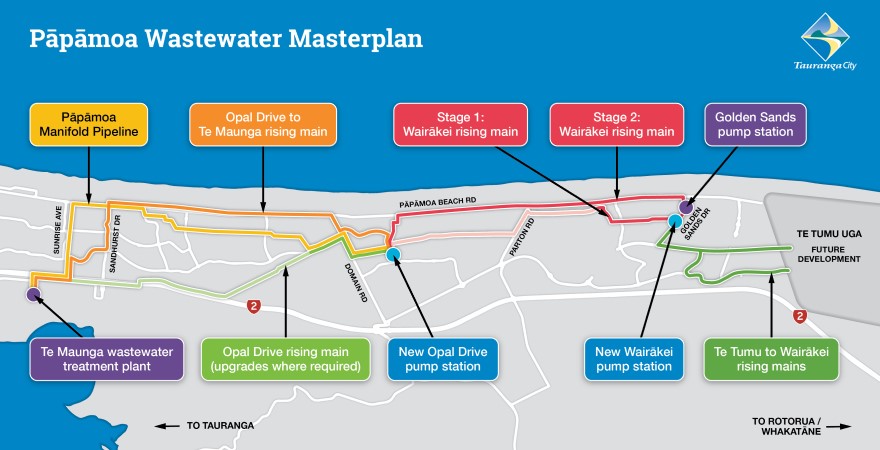As part of our planned wastewater services upgrade in Pāpāmoa East, we will complete seven key projects between 2024 and 2042 to help build capacity and resilience in the wastewater network.
We know people want to live and work in Tauranga, and this is driving the need for significant investment to accommodate the growth we're experiencing in our Pāpāmoa East suburbs. Investment in these major projects will benefit those who live, work and spend time in the wider area both now and well into the future.
A resilient wastewater network
We’re making this investment now to make sure we have a wastewater network that is safe, robust, and fit for the future. The existing infrastructure is running out of capacity to service our growing suburbs, as well as upcoming developments like Te Tumu.
Significant investment is needed to provide wastewater services that help to protect the environment and public health, as well as a platform for future infrastructure in the wider area.
Our projects include:
- Opal Drive wastewater pipeline upgrade - completed.
- New Opal Drive Pump Station - underway, to be completed in mid-2026.
- Wairākei Rising Main: Stage 1 – 2023 – 2028. This involves upgrades to the existing wastewater network to enable increased flows from the new Wairākei Pump Station. More information to come soon, as the project starts the design stage.
- Opal Drive to Te Maunga Rising Main - 2024 – 2038. Currently in the planning stage, we are looking at when upgrades are needed to meet the growing community’s future needs. This could involve building a second, additional wastewater pipe to take additional flows, or other alternatives.
- Pāpāmoa manifold pipeline – 2024 - 2035. We are in the planning stage for this project, working to identify the most feasible option to enhance the resilience of the current system, ensuring we maintain levels of service and also upgrade to accommodate an increase in future flows.
- Te Tumu Rising Main – 2028 – 2039. Project to connect new development in Te Tumu to the existing wastewater system. This is based on timing of the Te Tumu Urban Growth Area development; more information coming soon.
- Wairākei Pump Station – 2023-2028. A new pump station located in the Wairākei reserve next to Golden Sands School is currently in design, more information coming soon.
- New Wairākei Rising Main: Stage 2 – 2035 - 2040. At present, it is expected a second, additional rising main will be needed to convey flows from the Wairākei Pump Station to Opal Drive to accommodate future growth. Timing is dependent on growth in the eastern corridor.

Frequently Asked Questions
What is a rising main?
A rising main is a pressurised pipeline that pumps sewage from a lower point such as pipes, to a higher point, such as a wastewater treatment plant. It's an important tool for managing wastewater where gravity flow is not strong enough i.e. due to the flat landscape of Pāpāmoa.
What is a pump station?
A wastewater pump station is an underground facility that collects and pumps wastewater to the treatment plant or other pump stations. As we can’t rely on gravity to get sewage sent over up-gradients – in our case to the Te Maunga Wastewater Treatment plant - sewage needs to be pumped there.
Across Tauranga, we have a network of smaller, local pump stations that collect and transfer wastewater to larger pump stations. For example, 24 local pump stations pump to the Opal Drive pump station which then pumps to the Te Maunga wastewater treatment plant.
It has a range of key components, including:
- A wet well, which is an underground tank that collects wastewater from local households (and businesses) and allows larger pumps to operate more efficiently.
- Pumps, which are used to pump wastewater through a pressurised pipe system, also known as a rising main. Wastewater flows come in with gravity or pumped from other (smaller) local pump stations, it is collected in a wet well and then pumped via rising mains to the treatment plant.
- Level sensors, which detect the level of wastewater in the wet well and trigger the pumps to start when the level reaches a certain set point.
- Control panels help monitor the pump station and send alerts to our wastewater engineers if any problems are found.
What is the manifold pipeline?
A manifold refers to a central hub that distributes or collects fluids, like water, from a single source to multiple destinations, or vice versa. It can be a pipe fitting or a system of pipes, valves, and fittings that allows for the branching of a main pipeline into multiple smaller pipes.
In Pāpāmoa, a manifold pipeline is used to transport wastewater from a catchment near Opal Drive to the Te Maunga Wastewater Treatment Plant (WWTP) in the west, using one main pressurised pipe into which a number of pump stations are connect.